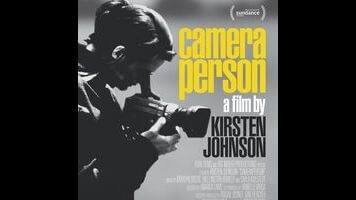Cameraperson foregrounds that sort of violation. Director Kirsten Johnson has worked primarily as a cinematographer on documentaries, collaborating with everyone from Michael Moore to Laura Poitras; the footage in this movie was originally shot for about two dozen other projects. It’s a collection of leftovers, basically: images Johnson’s camera captured that didn’t make the final cut, but which stuck with her nonetheless. The most memorable of these snippets provide a sense of what Johnson’s job entails, making it clear just how much of the “objective reality” seen in docs has been arranged—not with an intention to deceive, necessarily, but just in an effort to improve the shot. At one point, Johnson’s hand enters the frame and plucks a tall blade of grass that’s obscuring the view. Later, we see her keep slightly moving an object—not the shot’s focus, nor even very important—until she presumably decides it’s in the right place to balance the composition. Stuff that normally gets trimmed has been afforded a showcase.
Not everything fits this conceptual approach, however. Many of Cameraperson’s vignettes (each identified solely by location, though a list of the original documentaries appears in the closing credits) are compelling or affecting, but play more like a greatest-hits compilation than like meta-textual outtakes. Often, it’s hard to fathom why footage wasn’t included in the film for which Johnson originally shot it. Jasper County’s district attorney, for example, exhibits and discusses the physical evidence in the James Byrd Jr. murder trail, including the chain used to drag Byrd for miles behind a pickup truck; it’s harrowing to watch, but seems like it’d be much better suited to Two Towns Of Jasper (2002) than it is to this quasi-memoir. Other bits and pieces are somewhat meaningless out of context—only those aware that Johnson worked on Citizenfour, Poitras’ documentary about Edward Snowden, will likely appreciate the sight of a thumb drive being thrown in wet cement and encased in a building project. (“Location withheld,” that one wryly says.)
Thematic unity isn’t everything though, and Cameraperson offers enough singular, rarely seen moments to compensate for the overall messiness. Johnson’s offscreen noises tell a wide-ranging story on their own, from her giggle every time something funny happens to her tiny groans when a little boy she’s filming in Bosnia—maybe 2 or 3 years old—starts playing with an ax while left unattended. (She keeps muttering “Oh, Jesus,” but she doesn’t intervene. Discuss.) And even the material that seems out of place, in the somewhat paradoxical sense that it wouldn’t seem out of place in an ordinary doc, strengthens one’s sense of who Johnson is and what interests her. As an autobiography told in pictures rather than words (including occasional glimpses of Johnson’s parents and her children), Cameraperson makes a strong case for the merits of the observational life. As a bonus, it also demonstrates what it looks like when the person who’s holding the camera sneezes.


 Keep scrolling for more great stories from The A.V. Club.
Keep scrolling for more great stories from The A.V. Club.